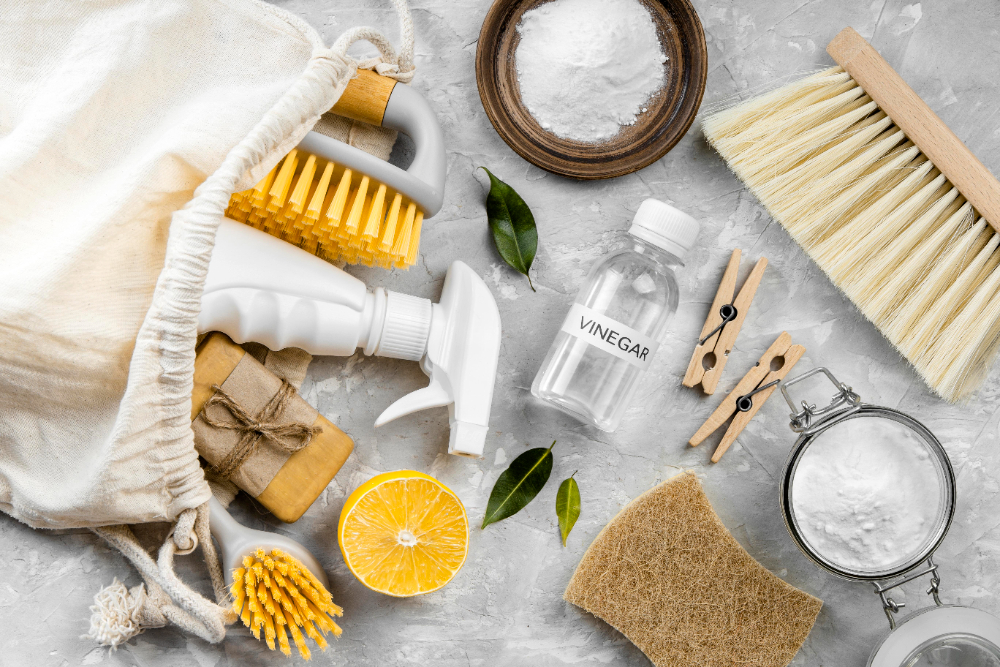Copper is a timeless material, renowned for its beauty and functionality in cookware, decor, and utensils. Its excellent heat conductivity and durability make it a favorite choice for chefs and homemakers alike. However, its gleaming surface often succumbs to tarnish over time due to exposure to air and moisture, which leads to the formation of copper oxide. Instead of resorting to chemical-laden cleaners, you can use natural, affordable, and eco-friendly methods to restore copper’s shine. These options are not only better for the environment but also safer for you and your family, reducing exposure to harmful substances. Here, we explore three effective DIY solutions using common household ingredients.
Using Lemon and Salt to Clean Copper
Lemons aren’t just for zesting your dishes; they’re a powerful natural cleaning agent for copper. Here’s how to use lemon and salt effectively:
- Cut a Lemon in Half: Take a ripe, fresh lemon and slice it in half. Using a ripe lemon ensures there is plenty of juice available for effective cleaning.
- Add Salt: Sprinkle table salt generously over the cut surface of the lemon. Coarse salt can also be used for additional scrubbing power, but table salt is ideal for general cleaning.
- Scrub the Copper: Rub the salted lemon directly onto the tarnished copper. The acidity of the lemon dissolves copper oxide, while the salt acts as a gentle abrasive.
- Rinse and Buff: Wash the item with warm water and dry it with a soft cloth for a brilliant finish. Warm water helps to dissolve and rinse away any remaining cleaning residue more effectively than cold water, ensuring a spotless surface.
This method works well for smaller items like jewelry or pots but can also be scaled for larger surfaces.
How to Make a Vinegar and Baking Soda Paste for Copper Cleaning
Vinegar and baking soda are household staples that form an effective paste for cleaning copper:
- Mix the Paste: In a small bowl, combine one tablespoon of baking soda with approximately two to three tablespoons of white vinegar to create a thick, spreadable paste.
- Apply to Copper: Use a soft cloth to spread the paste over the tarnished areas. For stubborn spots, allow the paste to sit for 10-15 minutes. This duration gives the acid in the vinegar and the abrasiveness of the baking soda enough time to break down tough tarnish effectively.
- Gently Scrub: Rub the paste into the copper using a non-abrasive sponge or cloth.
- Rinse and Dry: Rinse thoroughly with warm water and dry with a clean microfiber towel to reveal the restored shine. Using a microfiber towel helps avoid scratching and ensures a streak-free finish.
The mild abrasiveness of baking soda complements the acidity of vinegar, making it ideal for tough stains and grime.
The Effectiveness of Ketchup in Cleaning Copper Surfaces
Believe it or not, ketchup—a condiment found in most American kitchens—is a surprisingly effective copper cleaner. Here’s how to use it:
- Apply Ketchup: Spread a generous layer of ketchup over the tarnished surface.
- Let It Sit: Allow the ketchup to work its magic for about 10-15 minutes. This time frame is optimal for the acidity and salt in the ketchup to effectively dissolve the tarnish without overexposure, which could dry out the cleaner or lessen its impact. The acidity of the tomatoes and the vinegar content dissolve tarnish.
- Rub and Rinse: Use a soft, lint-free cloth or a non-abrasive sponge to rub the ketchup over the copper, then rinse with warm water. This prevents scratching while ensuring effective cleaning.
- Buff Dry: Finish by drying the item with a soft, lint-free cloth. This helps prevent streaks or residue, leaving the surface gleaming and spotless.
This method is quick, non-toxic, and perfect for smaller items or areas with light tarnish.
Why Choose Natural Cleaners for Copper?
Natural cleaners are not only cost-effective but also safer for your family and the environment. They minimize exposure to toxic chemicals, reduce water pollution, and lower the risk of harmful residues on cookware. By choosing natural options, you also contribute to sustainable practices that benefit future generations. Unlike commercial cleaners, which often contain ammonia, phosphates, and synthetic fragrances, they don’t expose you to harsh chemicals. Plus, these DIY methods rely on ingredients you likely already have in your pantry, such as lemon, salt, vinegar, baking soda, and even ketchup.
If you’re looking for more ways to maintain your copper mugs, check out this guide, which includes tips on preventing tarnish and achieving long-lasting shine for additional tips. Keeping your copper cookware and decor in top shape has never been easier—or more sustainable. Regular maintenance reduces the need for replacements, minimizing waste, and avoids using harsh chemicals that can harm the environment. Embracing these natural solutions ensures a longer life for your copper items while promoting eco-friendly habits.
Conclusion
Cleaning copper naturally not only preserves its stunning appearance but also supports a healthier home and environment. By avoiding chemical cleaners, you help reduce water contamination and minimize the release of harmful substances into the ecosystem. By using simple ingredients like lemon, salt, vinegar, baking soda, and even ketchup, you can achieve professional-level results without harsh chemicals. The acidity in lemon, vinegar, and tomatoes effectively dissolves tarnish, while salt and baking soda provide gentle abrasive properties for thorough cleaning. Whether you’re preserving cherished heirloom pieces with sentimental value or maintaining practical everyday cookware, these DIY solutions offer a versatile, affordable, and sustainable approach to caring for your copper items. Let these methods inspire you to keep your kitchen essentials shining for years to come.

